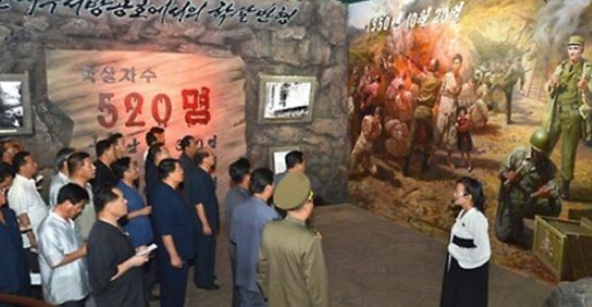The April 27 inter-Korean summit must bring about peace, prosperity, unification, denuclearization and progress in US-DPRK relations.
Peaceful coexistence must be established in a way that cannot easily be undone. The most important change needed is within the US-DPRK relationship.
There are no formal diplomatic relations between the two countries. North Korea has a UN ambassador who resides in New York and who acts as a communication channel to the outside world. The Swedish consulate in Pyongyang manages North Korea-related diplomacy relevant to the US. Sweden is a neutral country and maintains diplomatic relations with North Korea.
The Korean War began with North Korea’s invasion of South Korea, and the US military took a leading role in countering the invasion until the armistice was signed. After the end of the war, and throughout the Cold War, the US-North Korea relationship was marked by incidents including the Panmunjom Axe Murder Incident and the Pueblo Incident, which only worsened their relationship.
History shows that each time a crisis has erupted between the two countries, the US has taken a “two-track approach” in an effort to show good faith to North Korea. This was particularly the case during the 1994 nuclear crisis when former President Jimmy Carter met with Kim Il Sung, and the 2016 informal meeting in Kuala Lumpur can be seen in the same light.
There was another event on November 4, 2007, that is worth revisiting. A North Korean vessel was attacked by Somali pirates and a US warship in the area arrived to save it. The US Navy gave permission for the North Korean sailors to board their vessel for medical assessment and the North Korean state media even thanked the US for the “help it gave to our sailors.”
In 2008, the New York Philharmonic Orchestra visited Pyongyang to hold a performance. Former President Carter’s visit to Pyongyang in 1994 helped to create a new atmosphere, but Kim Il Sung’s death and Kim Jong Il’s aggressive attitude in the face of a domestic power crisis led to a worsening in US-DPRK relations once again.
Former President Bill Clinton visited North Korea in 2009 to negotiate the return of two Asian-American journalists who were held there. Carter returned to North Korea again in 2010 but failed to meet Kim Jong Il (who was in China at the time).
North Korea has generally failed to keep its promises, and each time a promise was broken it was blamed on the American “tendency toward invasion”, with strong doses of anti-American rhetoric being blasted at its citizens for good measure.
From North Korea’s perspective, the country has a significant interest in establishing official relations with the US, but it will not be easy to improve the bilateral relationship. This is because the anti-American propaganda aimed at keeping the Kim clan in power throughout the past three generations is extraordinarily deep-rooted in North Korean society.
North Korea is reportedly completely shutting down its Punggye-ri nuclear site in Kilju, North Hamgyong Province. Denuclearization is important for peace and prosperity on the Korean Peninsula and the world. The shutting down of the nuclear site is thus an important step and will be greatly welcomed by the international community.
Curiously, the anniversary of the start of the Korean War (June 25) comes just days after the planned US-DPRK summit on June 12, and North Korea typically launches a massive anti-American campaign called the “Anti-American Campaign Month” from that very day. Whether North Korea calls off its campaign this year remains to be seen.
North Korea must shut down its nuclear program if it wants to show the international community that it truly wants an improvement in US-DPRK relations and peace. To maintain its hold on power, the North Korean regime has built a museum in Sinchon that is aimed at sowing anti-American sentiment in the North Korean population.
This museum is a centrepiece of anti-American propaganda in North Korea. Kim Il Sung and Kim Jong Il found time to visit the museum and called the US ‘wolves in human clothing’ that are ‘our most evil of enemies’. Chairman Kim Jong Un visited the museum in November 2014 to criticize the US directly.
North Korean media at the time reported that Kim Jong Un said, “The US imperialist invaders are very clearly showing they are man-eating murderers who enjoy massacring human beings,” and that, “Any fantasy held toward the enemy means the abandonment of the revolution and the eventual destruction of the revolution.”
The North Korean authorities are spreading propaganda claims that the US military committed a massacre of civilians in Sinchon during the Korean War as part of their efforts to promote solidarity amongst North Koreans against the US “invaders.” North Korea claims that the US military killed approximately 35,000 civilians in Sinchon during the Korean War.
This is not accurate, however. While it is true that civilians were massacred in Sinchon during the war, there is evidence that it had nothing to do with the US. According to materials from the US National Archives, the US military reported that a cruel massacre occurred between Sinchon residents who were divided along political lines in Hwanghae Province on October 13, 1950. The North Korean authorities have claimed that the US military was behind the massacre as a way to provide legitimacy to the regime, but the North Korean elite are aware of the truth of the matter. A North Korean TV drama has even acknowledged that the massacre in Sinchon was due to ideological disputes between local residents.
The North Korean regime has long incited hatred toward the US and mandated anti-American education for its citizens by creating the Sinchon Museum. The shutdown of the nuclear site is important, but North Korea will need to reconsider the Sinchon Museum if it wants its change of heart to be taken seriously.





















